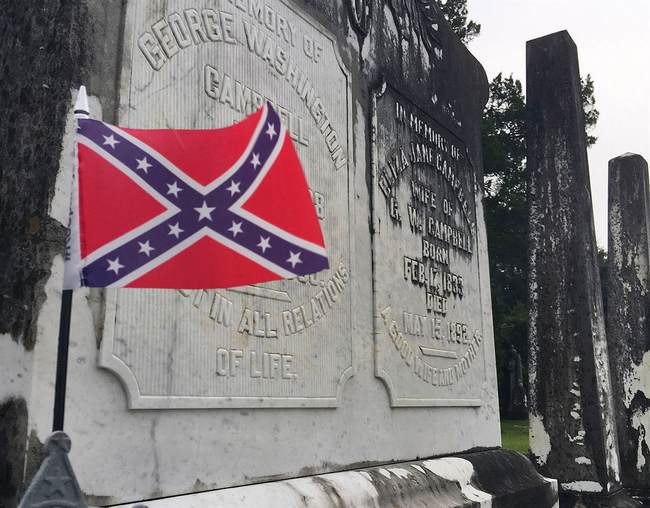
Work crews in Dekalb County, Georgia, installed a statue of civil rights leader and Congressman John Lewis at the same spot where a controversial monument to the Confederacy had stood for over a century.
The development comes nearly four years after the Confederate monument in Decatur was dismantled in 2020 amid the furor over the death of George Floyd, which ignited nationwide protests and riots.
Work crews gently rested the 12-foot-tall (3.7-meter-tall) statue into place as the internationally acclaimed sculptor, Basil Watson, looked on carefully.
“It’s exciting to see it going up and exciting for the city because of what he represents and what it’s replacing,” Watson said, as he assisted with the installation process.
Lewis was known for his role at the front lines of the Civil Rights Movement and urged others to get in “good trouble” for a cause he saw as vital and necessary. In DeKalb County where the Confederate monument stood for more than a century, protesters have invoked “good trouble” in calling for the swift removal of the obelisk.
A large bronze statue of the late civil rights leader and Georgia congressman John Lewis has been installed, at the very spot where a monument to the confederacy stood for more than 110 years in Decatur, GA’s town square, before it was dismantled in 2020.. pic.twitter.com/imPCclWBC4
— Old Man Lefty (@OldManLefty1) August 17, 2024
The stone obelisk monument to the Confederacy was lifted from its base in 2020 as onlookers shouted, “Just drop it.”
The statue was originally erected in 1908 by the United Daughters of the Confederacy (UDC) using contributions from the United Confederate Veterans. It was a 30-foot obelisk made out of granite. It was inscribed with four panels that displayed the virtues of Confederate soldiers, emphasizing ideals such as loyalty, bravery, and commitment to the cause of the Confederacy.
The monument, similar to others built in other areas of the country after Reconstruction, promoted the “Lost Cause” narrative, a revisionist interpretation of the Civil War that portrayed the actions of the Confederacy as noble and just, downplaying the role slavery played in the conflict.
“Lost Cause” history began to take shape soon after the conclusion of the Civil War. Leading figures in the South sought to reconcile their defeat while preserving a semblance of honor and cultural identity. Key elements of this narrative framed the Confederacy’s cause as a fight for states’ rights rather than the preservation of slavery, whose role was typically minimized or even portrayed as a benign institution that was ultimately beneficial to black Americans.
Slavery, meanwhile, is sentimentalized in the context of the Lost Cause. Following the war, white Southerners told stories of the “happy slave”—the “Mammy” or “Uncle Tom” who was considered part of the family. “Generally speaking, the negroes proved a harmless and affectionate race, easily governed, and happy in their condition,” according to the 1908 edition of the textbook History of Virginia by Mary Tucker Magill. The 1964 edition of Virginia: History, Government, Geography by Francis Butler Simkins, Spotswood Hunnicutt Jones, and Sidman P. Poole was not much different. “A feeling of strong affection existed between masters and slaves in a majority of Virginia homes,” the authors wrote. Such statements are not supported by modern scholarship, which suggests that many enslaved people were desperate to escape their often harsh conditions both before and during the war. In fact, enslaved laborers who escaped helped to precipitate national political crises such as the one surrounding the Fugitive Slave Act of 1850.
The ”Lost Cause” myth also reinterpreted Reconstruction as a period of Northern exploitation, painting the South as an innocent victim of unjust policies imposed by “carpetbaggers,” northerners who moved South after the war. The narrative was disseminated through various avenues, including schools, textbooks, public speeches, events, and monuments. It was also used to justify the disenfranchisement and segregation of black folks by depicting them as unfit for citizenship.
The Dekalb County monument was part of a broader movement during the late 19th and early 20th centuries to commemorate the Confederacy. They were erected in public spaces such as town squares and courthouses instead of on battlefields or cemeteries. The placement of the monuments is seen as symbolic, serving as a reminder of the social order proponents of the Confederacy sought to impose during the Jim Crow era.
The UDC played a significant role in these efforts, promoting the idea that the Civil War was fought solely over states’ rights rather than slavery and that Confederate soldiers were heroes defending their way of life. The organization was founded in 1864 in Nashville, Tennessee, to celebrate the Confederacy and its soldiers. It played a significant role in establishing Confederate monuments and promoting the “Lost Cause” historical narrative.
The organization’s objective was to create educational initiatives to glorify Confederate history and reshape the narrative surrounding the Civil War. The UDC seeks to “protect, preserve and mark the places made historic by Confederate valor, “assist descendants of worthy Confederates in securing proper education,” and “[t]o honor the memory of those who served and those who fell in the service of the Confederate States,” according to the group’s website.
Over time, the monument, as well as others, became the subject of controversy, especially during the George Floyd debate. However, even before the incident, some called for removing the monuments, many of which were erected by the UDC to honor Confederates, white supremacists, slaveholders, and others. As a result, cities across the country have either removed or relocated the monuments.